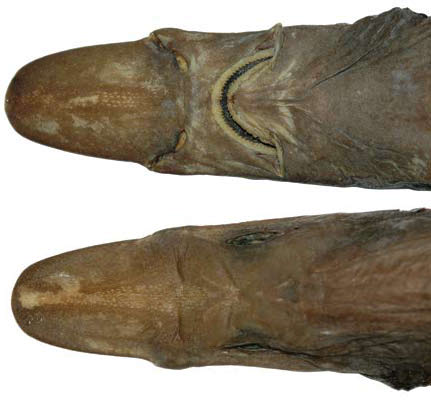Apristurus australis
Sato, Nakaya & Yorozu, 2008
Classification: Elasmobranchii Carcharhiniformes Pentanchidae
Reference of the original description
Apristurus australis sp. nov., a new long-snout catshark (Chondrichthyes: Carcharhiniformes: Scyliorhinidae) from Australia. CSIRO Marine and Atmospheric Research Paper, 22, 113–122
Apristurus australis sp. nov., a new long-snout catshark (Chondrichthyes: Carcharhiniformes: Scyliorhinidae) from Australia. CSIRO Marine and Atmospheric Research Paper, 22, 113–122
Image of the original description

Head of Apristurus australis sp. nov, holotype CSIRO H 953–07 (mature male 616 mm TL): ventral view; dorsal view. Scale bar = 10 mm. In: SATO, K. & Nakaya, K. & YOROZU, M. (2008): Apristurus australis sp. nov, a new long-snout catshark (Chondrichthyes: Carcharhiniformes: Scyliorhinidae) from Australia. CSIRO Marine and Atmospheric Research Paper, 22: 113-122

Head of Apristurus australis sp. nov, holotype CSIRO H 953–07 (mature male 616 mm TL): ventral view; dorsal view. Scale bar = 10 mm. In: SATO, K. & Nakaya, K. & YOROZU, M. (2008): Apristurus australis sp. nov, a new long-snout catshark (Chondrichthyes: Carcharhiniformes: Scyliorhinidae) from Australia. CSIRO Marine and Atmospheric Research Paper, 22: 113-122
Synonyms / new combinations and misspellings
Apristurus cf. australis, Pentanchus australis
Apristurus cf. australis, Pentanchus australis
Types
Apristurus australis
Holotype: CSIRO: H 953-07; Paratype: AMS: I.24037-007; AMS: I.20452-020; AMS: I.20068-016; CSIRO: T 459; CSIRO: H 860-02; CSIRO: H 616-05; CSIRO: H 616-04; CSIRO: H 616-01; CSIRO: H 1539-02; CSIRO: H 1287-04; CSIRO: H 1286-02; CSIRO: H 1285-02; CSIRO: H 1229-02; CSIRO: H 1240-01; CSIRO: H 1229-01; CSIRO: H 1228-02; CSIRO: H 1201-09; CSIRO: H 1228-01; CSIRO: H 1287-01; HUMZ: 139951; HUMZ: 139949; HUMZ: 139947; HUMZ: 139948; HUMZ: 139946; HUMZ: 139950;
Apristurus australis
Holotype: CSIRO: H 953-07; Paratype: AMS: I.24037-007; AMS: I.20452-020; AMS: I.20068-016; CSIRO: T 459; CSIRO: H 860-02; CSIRO: H 616-05; CSIRO: H 616-04; CSIRO: H 616-01; CSIRO: H 1539-02; CSIRO: H 1287-04; CSIRO: H 1286-02; CSIRO: H 1285-02; CSIRO: H 1229-02; CSIRO: H 1240-01; CSIRO: H 1229-01; CSIRO: H 1228-02; CSIRO: H 1201-09; CSIRO: H 1228-01; CSIRO: H 1287-01; HUMZ: 139951; HUMZ: 139949; HUMZ: 139947; HUMZ: 139948; HUMZ: 139946; HUMZ: 139950;
Description :
Citation: Apristurus australis Sato, Nakaya & Yorozu, 2008: In: Database of modern sharks, rays and chimaeras, www.shark-references.com, World Wide Web electronic publication, Version 12/2025
Please send your images of "Apristurus australis" to info@shark-references.com

Apristurus australis sp. nov, holotype CSIRO H 953–07 (mature male 616 mm TL): lateral view (drawing); lateral view (photograph). Scale bar = 50 mm. In: SATO, K. & Nakaya, K. & YOROZU, M. (2008): Apristurus australis sp. nov, a new long-snout catshark (Chondrichthyes: Carcharhiniformes: Scyliorhinidae) from Australia. CSIRO Marine and Atmospheric Research Paper, 22: 113-122

Apristurus australis sp. nov, holotype CSIRO H 953–07 (mature male 616 mm TL): lateral view (drawing); lateral view (photograph). Scale bar = 50 mm. In: SATO, K. & Nakaya, K. & YOROZU, M. (2008): Apristurus australis sp. nov, a new long-snout catshark (Chondrichthyes: Carcharhiniformes: Scyliorhinidae) from Australia. CSIRO Marine and Atmospheric Research Paper, 22: 113-122
Short Description
This species has the following characters: flattened prenarial snout, apparently longer than interorbital width; furrows of upper labial much longer than the lower ones; pectoral fin widely expanding posteriorly, with outer margin a little longer than P1-P2 space; short abdomen, P1-P2 space narrower than preorbital length or anal fin base length; origin of first dorsal-fin just above or slightly anterior to pelvic-fin insertion; 50?64 and 48?68 tooth rows on upper and lower jaws, respectively; teeth with 5 or more cusps, including the anterior ones; egg capsule with no coiled tendrils on anterior and posterior ends, posterior end tapering toward tip; color preserved in alcohol is uniformly pale brownish to light greyish, sometimes light yellowish brown; the dorsal side of body is a little darker than ventral side [3338].
This species has the following characters: flattened prenarial snout, apparently longer than interorbital width; furrows of upper labial much longer than the lower ones; pectoral fin widely expanding posteriorly, with outer margin a little longer than P1-P2 space; short abdomen, P1-P2 space narrower than preorbital length or anal fin base length; origin of first dorsal-fin just above or slightly anterior to pelvic-fin insertion; 50?64 and 48?68 tooth rows on upper and lower jaws, respectively; teeth with 5 or more cusps, including the anterior ones; egg capsule with no coiled tendrils on anterior and posterior ends, posterior end tapering toward tip; color preserved in alcohol is uniformly pale brownish to light greyish, sometimes light yellowish brown; the dorsal side of body is a little darker than ventral side [3338].
Remarks
shark-references Species-ID=309;
shark-references Species-ID=309;
















